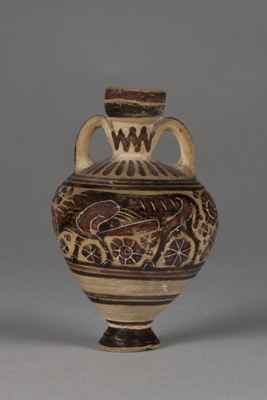< Collection search
< Collection highlights
From:UC Teece Museum of Classical Antiquities
Name/TitleAmphoriskos
About this objectThe amphoriskos ("small amphora") is a small jar with two handles, typically used for perfumes and oils. This vase is very close to Corinthian in style and shape. It is made of a similar clay as the pointed aryballos (JLMC 6.53) in the collection.
On this vase a frieze of animals runs around the body. A long-necked bird stands below one handle, behind an elongated panther. The panther faces a ram with his head down to graze. The surrounding spaces in the frieze are filled with rosettes. Details have been incised, similar to the Proto-Corinthian method that predated black-figure style. Red has been added to the animals and rosettes, adding depth and shape to the figures. Red has also been used for bands around the lower body and neck, and the zigzag and tongue patterns on the neck and shoulder.
During the Orientalising period, Etruscan artists incorporated many of the motifs of the Near East, often with a Greek influence. These included the use of plants and animals, often exotic or mythical. The more realistic portrayal of figures was a significant shift from the simpler geometric shapes of earlier styles.
Date MadeEarly 6th Century BCE
PeriodArchaic
Place MadeItaly
Medium and MaterialsCeramic: Pottery
Style and IconographyEtruscan
Style and IconographyOrientalising
TechniqueThrowing (pottery technique)
TechniqueIncising
TechniqueGlazing (coating process)
MeasurementsHeight 108mm; Diameter 69mm
Subject and Association KeywordsAnimals in art
Subject and Association KeywordsBirds in art
Subject and Association KeywordsCosmetics
Subject and Association KeywordsSocial life and customs
Named CollectionThe James Logie Memorial Collection, University of Canterbury, New Zealand
Credit LineDonated by M.K. Steven, 1953.
Object TypeStorage Vessels
Object number5.53
Copyright LicenceAll rights reserved
